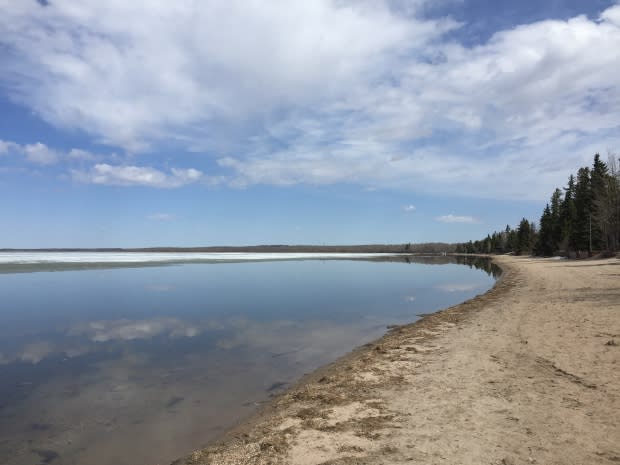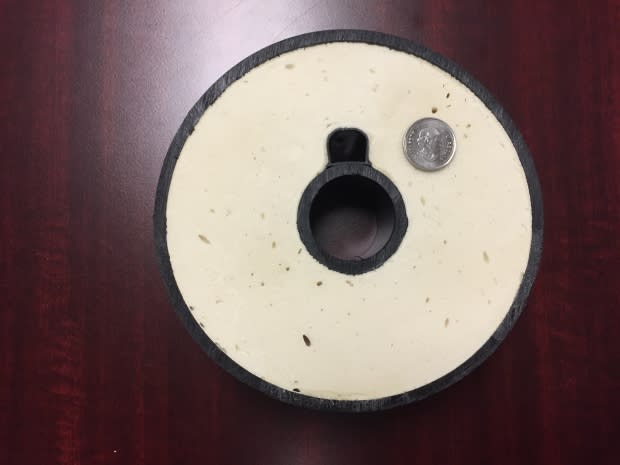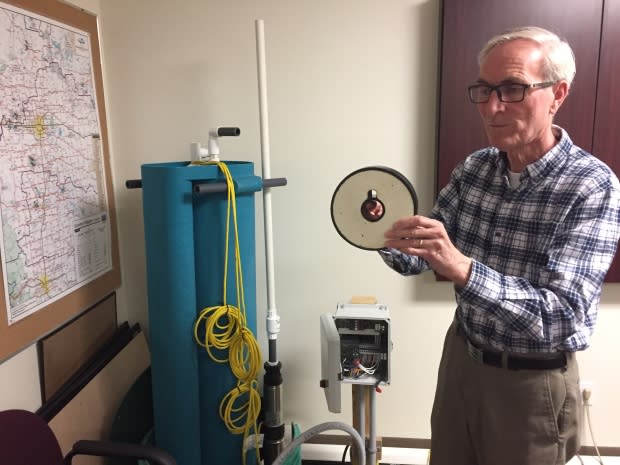Ma-Me-O Beach residents question new $3M sewage system
The Summer Village of Ma-Me-O Beach finally has a sewage system after more than 30 years of debating wastewater options. Still, some residents are raising concerns, saying that sections of pipe froze last winter and that hooking up to the main line is cost prohibitive.
Signs of sewer work are evident in the village, on the shores of Pigeon Lake, about an hour drive southwest of Edmonton. There are more than a dozen holes on the streets, about three feet deep and rimmed in orange snow fence and yellow caution tape.
At the bottom of each hole is a black sewer pipe, a visible reminder of the system that cost $3 million and was installed last fall.
A historic problem
Longtime property owners, like Al Barnhill whose family has owned a cabin in Ma-Me-O since 1947, recall years of debate over the best way to deal with waste in the village.
Barnhill, who lives in Lethbridge and uses his Ma-Me-O Beach cabin every summer, says his family installed a holding tank to collect wastewater back in 1988. They were early adopters. At that time, most people were still using septic systems, or worse.
"Outhouses were common," Barnhill said. "There was no legislation."

In 2012, the village council passed a bylaw requiring all homeowners to install a wastewater holding tank. Some residents, like Barnhill, already had them installed. For others, it was a $10,000 one-time cost, plus between $100 and $150 to get the tank pumped out.
Most residents pump their tanks at least once per month and up to twice a week, if they have lots of guests over busy summer weekends.
The tanks worked, but were not without their problems. According to Bob Mieske, who lives in the village year round, the trucks can be disruptive as they rumble along the unpaved roads. There is also the smell.
"When the pump trucks come, there is an odour," explained Mieske.
Mieske continued, trying to be polite, but smiling. "And, depending on the wind, your next door neighbour could be pumping and you could be having a barbeque," said Mieske. "And it's not the most, uh, fun time."
Building challenges
By 2016, the council wanted a more robust, and less smelly, system to manage wastewater.
Right away, a traditional sewer system was ruled out, due to the sandy soil and the village's lakeshore location, said Mayor Don Fleming.
"Traditional sewer systems are quite deep," Fleming said. "And when you flush, everything goes into the main line and then it gets carried off to a sewage treatment plant. In our case, we couldn't go any deeper than four or five feet, if that.
"If we put in [deep sewer] lines, they would simply bounce up to the top," Fleming said. "They would have air in them and it would be like trying to have air in a balloon underneath a pile of sand."
It was clear that the system would need to be shallow, using low-pressure pumps to move liquid.
One of the first proposed systems would used grinders to grind solids, removing the need for holding tanks altogether.
Divisive debate
By 2016, council started to look seriously at a low-flow system where solids would remain in existing holding tanks and greywater would be pumped out into the main sewer line. This would reduce the need for residential pump outs to once every year or two.
Barnhill, and others, viewed this as a partial system, since it still required pump outs. They also questioned the decision to install a brand new sewer system, less than five after residents were required to install $10,000 holding tanks.
"This system was not necessary. It was not needed," said Barnhill. "If I have a car that works perfectly well, do I have to go out and buy another car? Well, some people might but I am not one of those people."
There would be a connection cost, too. Any homeowner that wanted to connect their property to that greywater line would have to do so at their own cost. Fleming said this could be as little as $6,000.

However, Ron Lupton, who has lived in the village for 22 years, estimated it would cost him in excess of $25,000 to connect. A contractor said he would have to snake the pipe around existing electric and gas lines and potentially remove a large tree on Lupton's property.
Then, there was the issue of freezing. Lupton said he wondered how a pipe, buried only five feet deep, would work during the frigid winter months, when most residents close up their cabins.
In 2016 Lupton, and others, felt that council wasn't listening to concerns. They petitioned then Minister of Municipal Affairs Danielle Larivee, asking her to investigate council. Nearly 30 per cent of homeowners signed that petition to the minister.
In the following months, there were more petitions to council and also a series of articles and letters to the editors in local newspapers, from both opponents and proponents of the proposed system.
A way forward
The province did not investigate and in June 2017, town council voted for its favoured low-pressure system. To get around the freezing issue, it would use pre-insulated pipe that used an electrical line to add additioaln heat.
It would cost a total of $3 million, with the village paying for one third and federal and provincial grants covering the rest.
Construction started in 2018 and residents started hooking up to the new, low-pressure sewer system in the fall of 2018.
Terry Smith, neighbour to Lupton, who also lives in Ma-Me-O Beach year round, was one of the first to hook up. It cost him about $10,000 in parts and labour to connect to the line.
"I love it," Smith said, as he took a break from loading recycling into his white van. "I don't have to worry about flushing the toilet and all the dishwashing is easier."
However, there were problems.
"We are the only ones where it seems to be working," said Smith. "Everyone else froze up in the winter."
As feared, sections of the line froze, including the section connected to Mieske's house. The freeze was temporary and Mieske said the system is now working well for him. He remained optimistic.

"We have talked about a sewer system in this community for well over 30 years," said Mieske. "It is just nice to see that it is finally in place and we are continuing to move forward."
The mayor said the freezing problem was traced back to a faulty electrical line. Crews are now digging up the connections at every electrical box, checking and double checking to fix any similar issues.
"The company, because of the problem that occurred, has extended the warranty by one year, as a gesture of good faith, so we are quite confident," Fleming said.

For Lupton, the holes in the ground do not instill confidence. He sees them as an indication of a botched project and a waste of taxpayer dollars, at all three levels of government.
"If this system doesn't work, what do they do?" he asked. "With all these engineers, you would think that someone would know what kind of a system to put in here. And we questioned it all along, saying 'you guys, are you sure?' Because there were enough people who were knowledgeable, or they wouldn't have signed the petition. Why would they ignore those people?"


